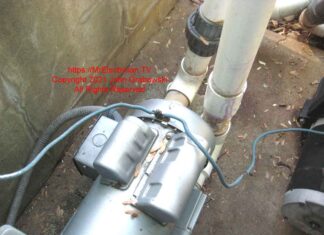Tag: Copper Crimp
Swimming Pool Bonding
Dear Mr. Electrician: How do I fix my in-ground swimming pool bonding wire?
Answer: Although swimming pool bonding wire is not difficult to fix if you know the National Electrical Code requirements. It is best left to professionals due to the high risk of injury or death if done improperly.
NOTE: Some text links below go to applicable products on Amazon. As an Amazon Associate, I earn from qualifying purchases. Using my links helps to keep this website FREE.
Article 680.26 Equipotential Bonding in the National Electrical Code determines swimming pool bonding methods needed for each pool.
Bonding of swimming pools, hot tubs, and other immersion pools is essential to reduce electrical shock hazards and the possibility of electrocution.
Water and electricity are not a safe combination, so the electrical installation must be done according to the National Electrical Code and local code requirements.
Below are photos of a commercial pool that failed inspection due to equipment bonding shortcomings.
In my state, commercial swimming pools must be inspected by a licensed electrical contractor every few years. The required inspection is a good thing because every time I have done a pool inspection, I have found problems. Most problems were not from the original swimming pool construction but due to repairs, changes, and a lack of good preventative maintenance.
Unfortunately, the state has no such inspection requirements for homeowner-managed swimming pools. Consequently, problems on residential homeowner pools are not caught unless someone working on the pool notices something is wrong or if someone gets hurt or dies.
Top Of Page
BONDING WIRE REPAIR
This is a close-up shot of the pool pump from the top of this page. Although it does have a bonding wire connected, the lug is not approved for two wires, only one. The photo below depicts my correction with a new lay-in lug and crimped wires.
A new tin-plated copper lay-in lug was installed, and the broken bonding wire was spliced together using a copper C tap and a crimping tool. I also used a copper split bolt connector to remove the crimps' strain.
The swimming pool pump motor above has its own built-in lay-in lug and set screw.
Lay-in lugs are favorable for use on pool equipment because they make it easy to replace the equipment without removing all the bonding connections. The bonding wire should never be cut.
Top Of Page
A pool heater with a lay-in lug and number 8 solid copper wire. All equipment associated with a pool must be bonded.
The above swimming pool lighting transformers were all required to be bonded. One of the bonding lugs had two wires in it. That would have been okay if the lug was approved for two wires, but it wasn't.
Two wires in a pool equipment bonding lug that was not approved for two wires. My fix is below.
I pulled the extra wire out of the lug and made a splice using a copper crimp and a copper split bolt connector.
I used a copper C tap crimp and a copper split bolt connector to join the wires for a low-resistance connection.
The...
